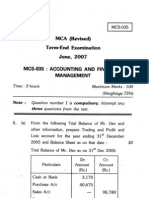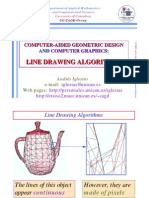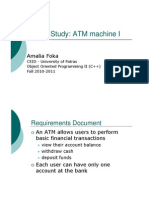Department of Applied Mathematics and Computational Sciences University of Cantabria UC-CAGD Group
2001 Andrs Iglesias. See: http://personales.unican.es/iglesias
COMPUTER-AIDED GEOMETRIC DESIGN AND COMPUTER GRAPHICS:
LINE DRAWING ALGORITHMS
Andrs Iglesias e-mail: iglesias@unican.es Web pages: http://personales.unican.es/iglesias http://etsiso2.macc.unican.es/~cagd
�Line Drawing Algorithms
The lines of this object appear continuous
However, they are made of pixels
2001 Andrs Iglesias. See: http://personales.unican.es/iglesias
�Line Drawing Algorithms
We are going to analyze how this process is achieved.
Some useful definitions
Rasterization: Process of
determining which pixels provide the best approximation to a desired line on the screen. lines.
2001 Andrs Iglesias. See: http://personales.unican.es/iglesias
General requirements
Straight lines must appear as straight
? ? ? ?
Scan Conversion: Combination
of rasterization and generating the picture in scan line order.
They must start and end accurately Lines should have constant brightness along their length Lines should drawn rapidly
�Line Drawing Algorithms
For horizontal, vertical and 45 lines, the choice of raster elements is obvious. This lines exhibit constant brightness along the length:
2001 Andrs Iglesias. See: http://personales.unican.es/iglesias
For any other orientation the choice is more difficult:
? ?
? ?
? ? ? ?
�Line Drawing Algorithms
Rasterization of straight lines.
? ?
? ?
or
Rasterization yields uneven brightness: Horizontal and vertical lines appear brighter than the 45 lines.
For fixing so, we would need: 1. Calculation of square roots (increasing CPU time) 2. Multiple brigthness levels
Compromise:
=>
1. Calculate only an approximate line 2. Use integer arithmetic 3. Use incremental methods
2001 Andrs Iglesias. See: http://personales.unican.es/iglesias
�Line Drawing Algorithms
The equation of a straight line is given by: y=m.x+b
Algorithm 1: Direct Scan Conversion
1. Start at the pixel for the left-hand endpoint x1 2. Step along the pixels horizontally until we reach the right-hand end of the line, xr 3. For each pixel compute the corresponding y value 4. round this value to the nearest integer to select the nearest pixel } x = xl;
2001 Andrs Iglesias. See: http://personales.unican.es/iglesias
while (x <= xr){ ytrue = m*x + b; y = Round (ytrue); PlotPixel (x, y); /* Set the pixel at (x,y) on */ x = x + 1;
The algorithm performs a floating-point multiplication for every step in x. This method therefore requires an enormous number of floating-point multiplications, and is therefore expensive.
�Line Drawing Algorithms Algorithm 2: Digital Differential Analyzer (DDA)
The differential equation of a straight line is given by: y2 - y1 y dy = constant or = dx x x2 - x1
2001 Andrs Iglesias. See: http://personales.unican.es/iglesias
The solution of the finite difference approximation is: xi+1 = xi + x yi+1 = yi + y2 - y1 x2 - x1 1 We need only compute m once, as the start of the scan-conversion. The DDA algorithm runs rather slowly because it requires real arithmetic (floating-point operations). y 1 DDA uses repeated addition
�Line Drawing Algorithms
DDA algorithm for lines with -1 < m < 1 x = xl; ytrue = yl; while (x <= xr){ ytrue = ytrue + m; y = Round (ytrue); PlotPixel (x, y); x = x + 1; }
-8 -7
Example: Third quadrant
-6 -5 -4 -3 -2 -1 0 0 -1 -2 -3 -4
2001 Andrs Iglesias. See: http://personales.unican.es/iglesias
Switching the roles of x and y when m>1
Reverse the roles of x and y using a unit step in y, and 1/m for x.
Gaps occur when m > 1
�Line Drawing Algorithms Algorithm 3: Bresenhams algorithm (1965)
Bresenham, J.E. Algorithm for computer control of a digital plotter, IBM Systems Journal, January 1965, pp. 25-30.
This algorithm uses only integer arithmetic, and runs significantly faster.
Y (1,1) (0,1)
2001 Andrs Iglesias. See: http://personales.unican.es/iglesias
Key idea: distance between the actual line and the nearest 1/2 m 1 grid locations (error).
Plot (1,1) 1/2 0 m 1/2 Plot (1,0) (0,0)
Initialize error: e=-1/2 Error is given by: e=e+m Reinitialize error: when e>0
?
(1,0)
� 2001 Andrs Iglesias. See: http://personales.unican.es/iglesias
Line Drawing Algorithms
Example: m=3/8
If e<0 below else above
below Error 0
below
above
above
Reinitialize error: e = 1/4 -1 = -3/4
Error: e=e+m
Initial value: e = - 1/2 e = -1/2+3/8 =-1/8 e = -1/8+3/8 = 1/4 e = -3/4+3/8 = -3/8
�Line Drawing Algorithms
However, this algorithm does not lead to integer arithmetic. Scaling by: 2* dx
void Bresenham (int xl, int yl, int xr, int yr) { int x,y; /* coordinates of pixel being drawn */ int dy, dx; int ne; /* integer scaled error term */ x = xl; y = yl; /* start at left endpoint */ ie = 2 * dy - dx; /* initialize the error term */ while (x <= xr){ /* pixel-drawing loop */ PlotPixel (x,y); /* draw the pixel */ if (ie > 0) { y = y + 1; ne = ne - 2 * dx; /* replaces e = e - 1 */ } x = x + 1; ne = ne + 2 * dy; /* replaces e = e + m */ } }
2001 Andrs Iglesias. See: http://personales.unican.es/iglesias
�Line Drawing Algorithms
Bresenhams algorithm also applies for circles.
Bresenham, J.E. A linear algorithm for incremental digital display of circular arcs Communications of the ACM, Vol. 20, pp. 100-106, 1977.
Key idea: compute the initial octant only
0 1 1 0 2 Reflect first octant about y=x
Reflect first quadrant about x=0 -1 0 0 1
1 3 4 4 2 1
Generate first octant
( )
2001 Andrs Iglesias. See: http://personales.unican.es/iglesias
Reflect upper semicircle about y=0
( )
1 0 0 -1
�Line Drawing Algorithms
Bresenhams incremental circle algorithm.
Example: circle of radius 8 Bright pixels: initial pixel (0,8) (1,8) (2,8) (3,7) (4,7) (5,6) (6,5) (7,4) (7,3) (8,2) (8,1) end pixel (8,0)
9 8
2001 Andrs Iglesias. See: http://personales.unican.es/iglesias
7 6 5 4 3 2 1 0 0 1 2 3 4 5 6 7 8 9





